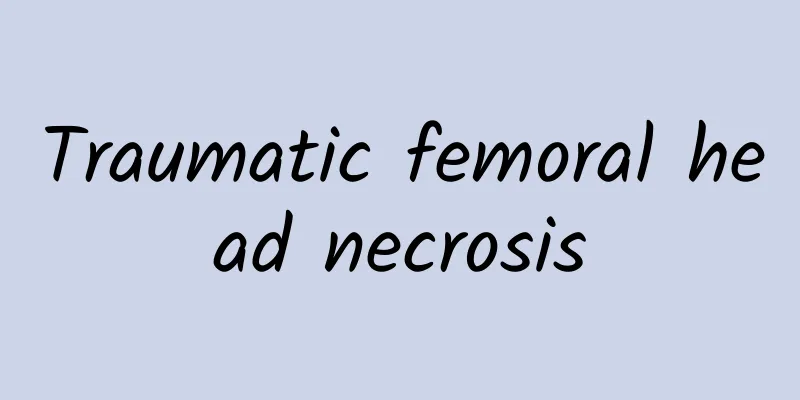Traumatic femoral head necrosis

|
Speaking of the disease of traumatic femoral head necrosis, I believe everyone is familiar with it. As the name suggests, it is due to certain external injuries, such as falling from a height, car accidents, or other accidents that lead to severe bone necrosis. In addition, with the continuous development of my country's transportation industry, the probability of some traumatic fractures has greatly increased, especially the incidence of traumatic femoral head necrosis has also increased. So what are the dangers of traumatic femoral head necrosis? In fact, traumatic femoral head necrosis is very harmful and can easily lead to bone deformation, and even bone cell necrosis, atrophy and other symptoms. Therefore, if you have this kind of disease, you should seek medical treatment in time, otherwise it will lead to irreversible consequences. Below I will give you a detailed introduction to the harmful effects of traumatic femoral head necrosis. Traumatic femoral head necrosis Introduction: In the past decade, with the rapid development of transportation and industry, the incidence of femoral neck fractures has shown a significant upward trend. Statistics show that the necrosis rate caused by femoral head fractures averages 25%-30%, and the occurrence of necrosis is closely related to many factors. Pathology of traumatic femoral head necrosis: Intertrochanteric fracture: Simple intertrochanteric fracture has less chance of damaging the blood supply to the femoral head and generally rarely causes blood supply disorders. Acetabular fracture: Acetabular fracture leads to femoral head necrosis. The occurrence of femoral head necrosis is related to the time and quality of its reduction. The earlier the reduction, the better the effect. Traumatic hip dislocation: Hip dislocation often occurs in young and middle-aged people, mostly due to great violence. The femoral head dislocates from the acetabulum, causing the round ligament of the femoral head to be stretched and ruptured, the joint capsule to become tense or even torn. Not only is the inferior epiphyseal artery ruptured, but the thousands of epiphyseal arteries are also often damaged to varying degrees. Femoral neck fracture: Avascular necrosis of the femoral head is prone to occur after a femoral neck fracture. It is generally believed that most of them occur 1-5 years after the fracture, and the earliest can occur 2-3 months after the injury. Causes of traumatic femoral head necrosis: The onset of femoral head necrosis is sustained by fractures and dislocations of the neck or hip that interfere with circulation. The blood supply and drainage to the head is severed because the vessels are circular in shape and the ligaments are torn. As a rule, the effects of destruction of the outer blood vessels are more severe in young people than in adult animals. The epiphyseal and metaphyseal anastomotic network was effectively erased to physically minimize the entire adult rabbit femoral head, otherwise the consequences would be serious obstruction of the external circulation. There are essential differences between traumatic osteonecrosis and other types of avascular necrosis of the femoral head in rabbits. Viable osteocytes with well-stained nuclei persist within the necrotic foci on both sides of the fracture line and cross the living bone-bone interface. However, when well-stained nuclei of viable osteocytes are absent, the fracture line passes through bone necrosis. Blood flow may be partially restored to vessels from the cervical medulla, but adequate flow will not be restored until reestablished circulation through the medial femoral circumflex artery and round ligament is restored. The harmfulness of traumatic femoral head necrosis Traumatic femoral head necrosis refers to the necrosis of living bone tissue in the human body. Traumatic femoral head necrosis is one of the diseases. Also known as aseptic ischemic necrosis of bone tissue, also known as aseptic necrosis. Femoral head necrosis is caused by hip trauma, long-term use of hormone drugs, alcohol poisoning, etc. Traumatic femoral head necrosis is caused by blood supply disorder, the femoral head bone tissue cannot get normal nutrition, causing the bone cells, bone marrow hematopoietic cells, and fat cells in the femoral head tissue to undergo necrosis. Traditional Chinese medicine believes that weak constitution, low disease resistance, and insufficient liver and kidney essence and blood lead to osteoporosis, which are potential causes of traumatic femoral head necrosis. Wind, cold, dampness and other reasons can also cause it. In short, there are both internal and external factors. The common core problem is the blood circulation disorder of the femoral head caused by various reasons, which leads to ischemia, degeneration and necrosis of bone cells. 1. Traumatic femoral head necrosis is harmful to the hip joint: the hip is an important hub connecting the human trunk and lower limbs. The hip joint supports the torso and connects to the lower limbs. It is the most necessary and critical part when people walk, sit or lie down. Therefore, hip joint disability has the greatest impact on the human body compared to disability of other joints. 2. Traumatic femoral head necrosis is difficult to detect in the early stages. Since the femoral head is located deep in the muscle layer, the lesions of traumatic femoral head necrosis are not easy to be discovered in the early stages. Once the femoral head is found to be diseased, the lesions of traumatic femoral head necrosis have often progressed to the stage of bone cell necrosis, trabecular deformation and atrophy, or have already developed corrosive changes and pitting sclerosis. Some patients may not even have any symptoms at this time. Precautions in the treatment of traumatic femoral head necrosis: In terms of life: long-term bed rest will cause atrophy of the lower limb muscles and complications such as bedsores. Patients must not stay in bed for a long time and must follow the doctor's instructions and perform rehabilitation functional exercises according to the treatment of the condition. Mentality: Patients with femoral head necrosis should get rid of the anxiety and impatience caused by the disease. Diet: no smoking and drinking, avoid spicy food, stale food, fatty food and animal offal, eat more foods that nourish the spleen and kidneys, strengthen the muscles and bones, supplement calcium and promote blood circulation. Treatment: Patients with femoral head necrosis must adhere to the course of treatment and must not give up halfway or continue the treatment intermittently. After reading the above detailed introduction to the harmful effects of traumatic femoral head necrosis, I believe everyone has a general understanding of this disease. In fact, traumatic necrosis of the femoral head requires medical treatment as soon as possible, and the general treatment plan is mainly based on promoting qi and blood circulation, and some massage and other methods are used to relieve joint pain. In addition, it is necessary to judge whether bone replacement is needed based on the different degrees of pain. Therefore, everyone should not be afraid of medical treatment because timely treatment can help cure the disease. |
>>: Is myocarditis contagious?
Recommend
How to treat Bell's palsy? Here are three methods
Speaking of Bell's palsy, I believe many peop...
What fruits can remove freckles?
In recent years, freckle removal has become the m...
How to cut the umbilical cord after childbirth
Today's medical technology is relatively adva...
What are the key points in nursing care for hemiplegic patients? How to care for patients with hemiplegia?
Hemiplegia, also known as half of the body paraly...
Testicles are wet and have an odor
The testicle is a very important reproductive org...
Can chronic gastritis eat glutinous rice?
Diet has always been the focus of attention for p...
How to remedy cold back after confinement
Because you lose blood when giving birth, and the...
Will I get pregnant if my period comes on time?
Women all know that if menstruation is delayed fo...
Can I eat passion fruit while breastfeeding?
Although there are many issues that we need to pa...
What causes tears in the eyes? 3 most common reasons
It is normal for your eyes to shed tears when you...
The efficacy and function of water rush
Many people may not have seen the plant water rus...
What are the early symptoms of Pankinson's disease?
Parkinson's disease is a relatively common an...
Is it necessary to seal children's pits and fissures?
For children, it is necessary to perform pit and ...
What to do if you have a dry cough
Dry cough is one of the more complex and common s...
It turns out that the kidneys, the most important part of men, cannot lack water?
The kidneys control water and store essence, and ...









